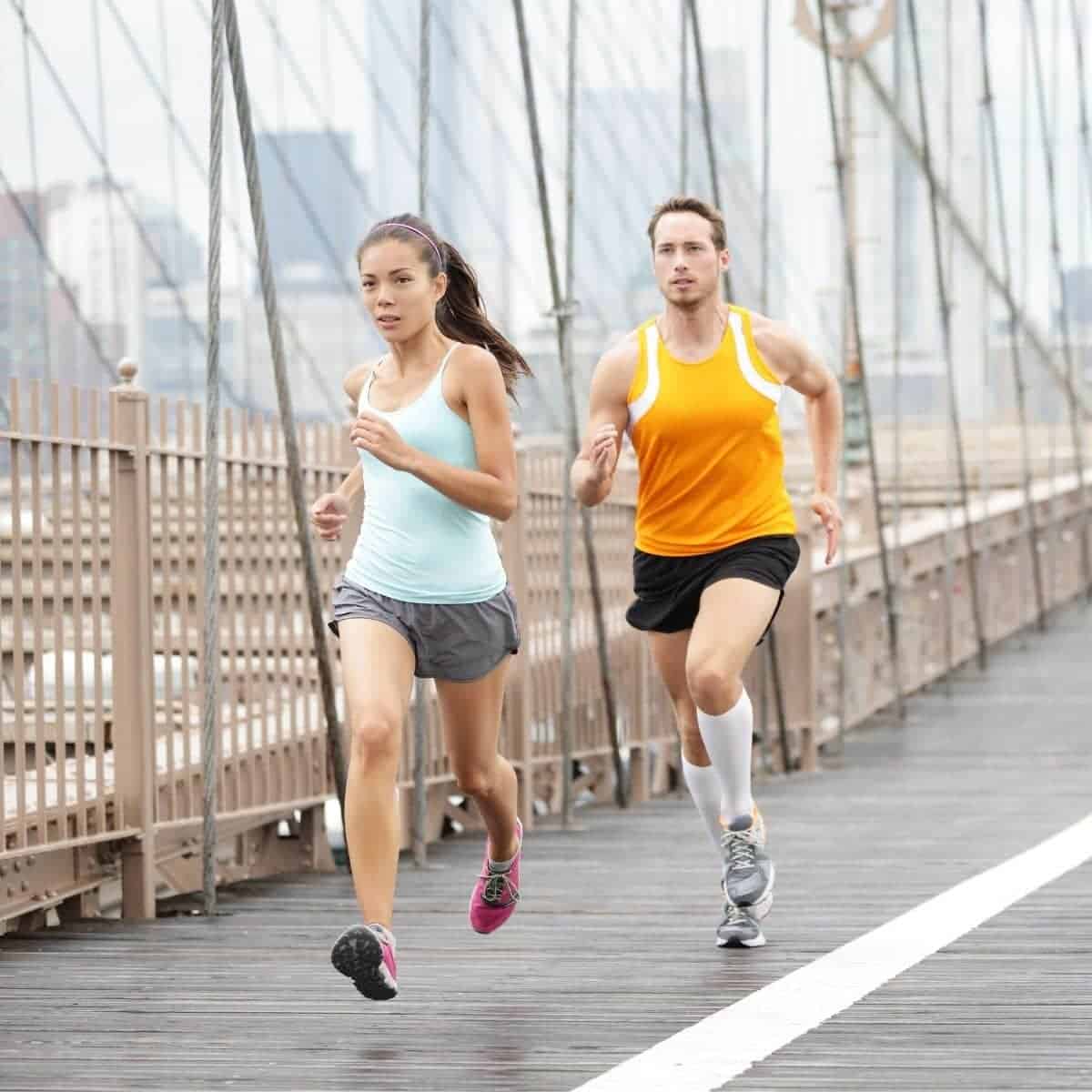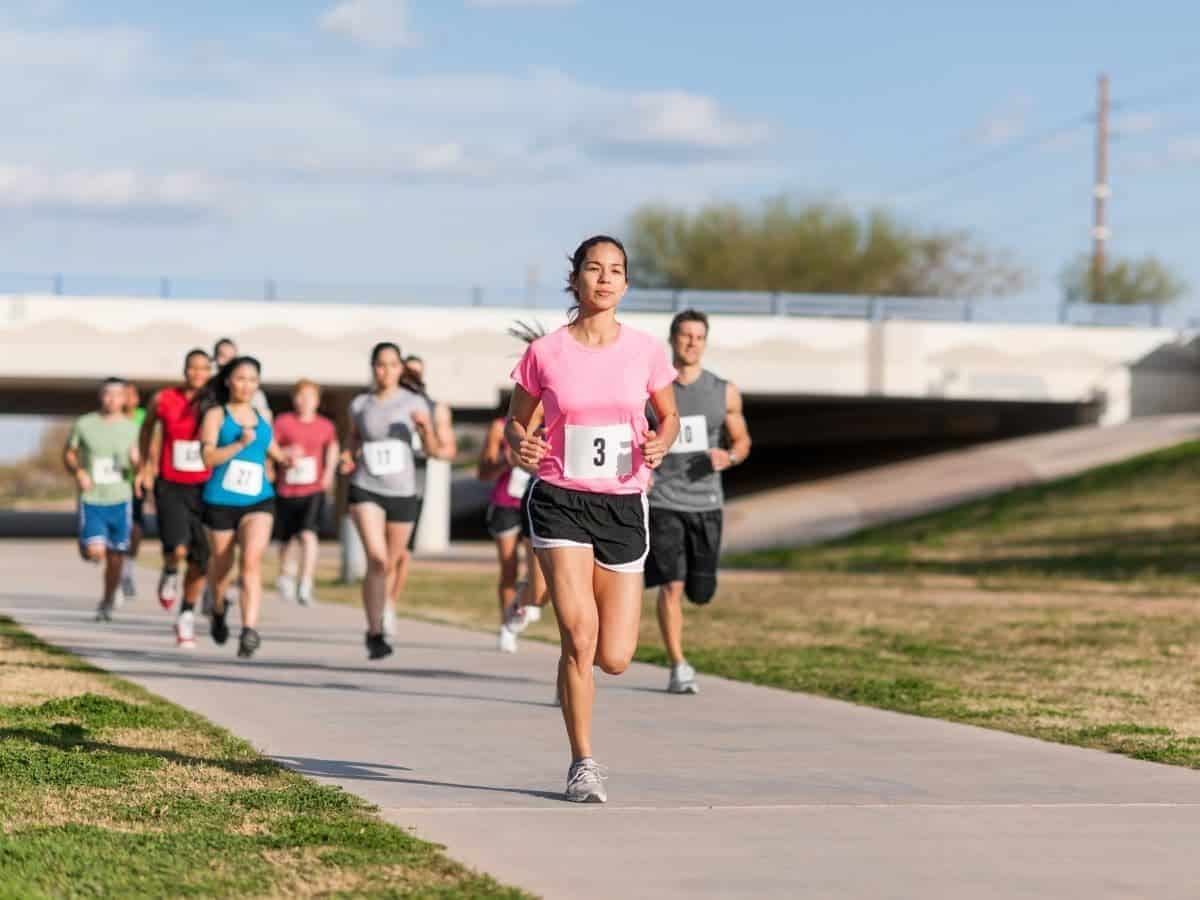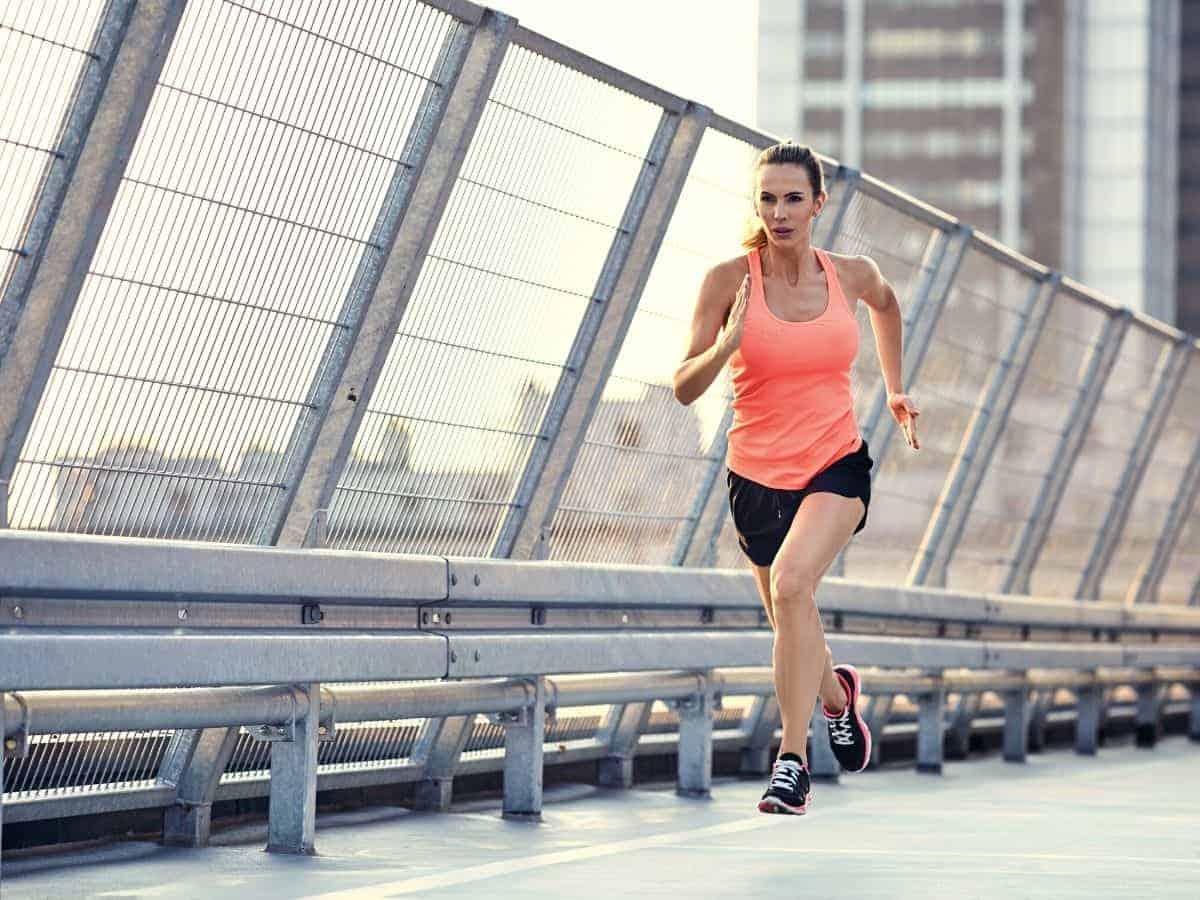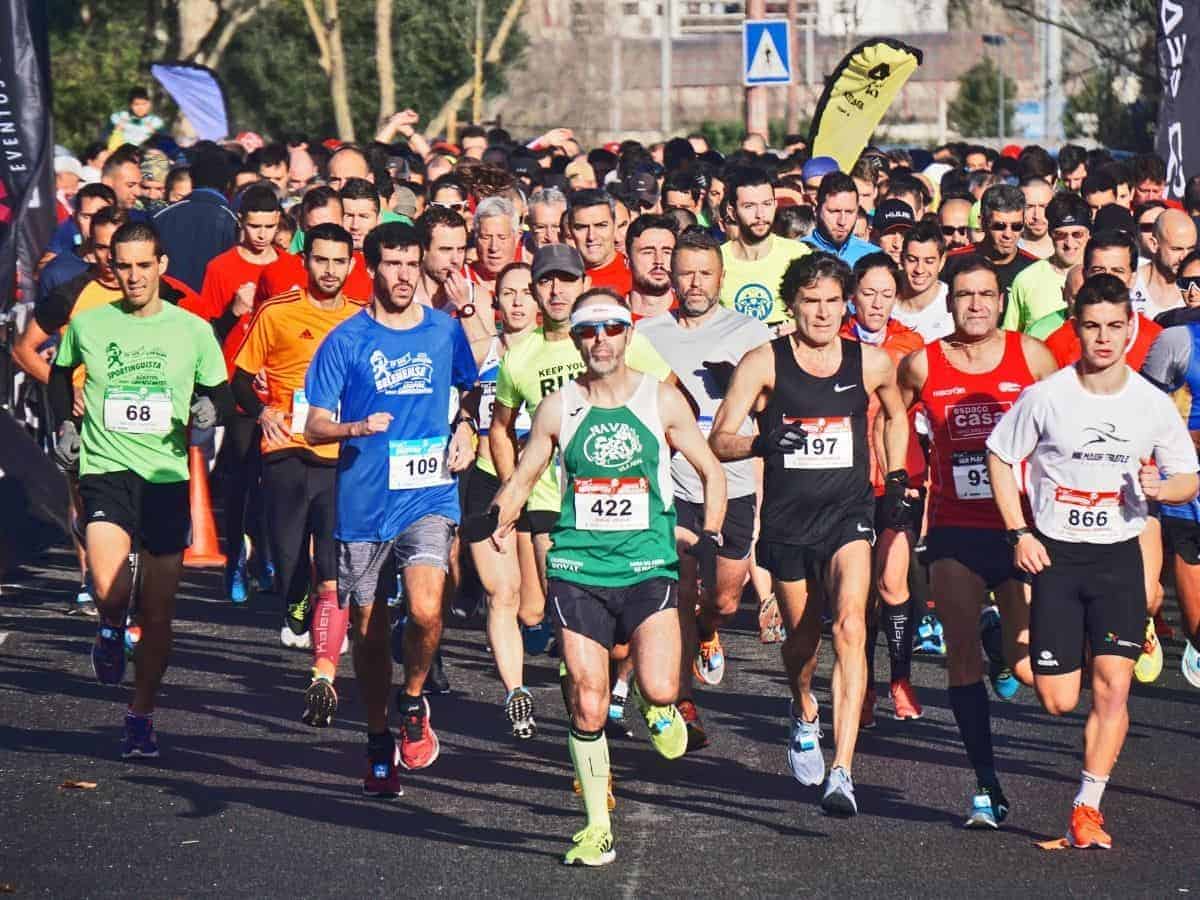To aesthetically photograph runners, you must prepare, use the proper settings, equipment, and have the right mindset.

Whether you’re photographing runners at a marathon, on a trail, the track, or in the city, the goal is to capture them in crisp focus.
When you photograph runners, there’s a lot to consider. Your camera settings, equipment, location, timing, and the shots you take are equally important.
Related article: What’s positive and negative space?
So, use the following tips to improve your running photography.
Preparation is key
Runners move quickly. So, you don’t have much time to think and figure out the composition. Regardless of the type of runner, preparation is required.
Before your photoshoot or a race, check out the location. If possible, walk on the route to find the best backgrounds and places along the path.
Additionally, consider the weather and position of the sun throughout the day. It ensures you find the perfect angles and where to stand.
Aside from the location, other crucial aspects of preparation are having a shot list, gear, and supplies.
Before your shoot, make sure your cameras, lenses, and memory cards work properly. Also, fully charge the batteries.
Depending on the length of your photo session, you may need to bring water and food.
Bring anything that’ll allow you to be at your peak in creativity and physical endurance.
For the shot list, think about all of the different types of images you want to capture. Writing them down is essential because it ensures you don’t forget.
Everything should be ready the night before the event or photoshoot. With excellent preparation, comes the best opportunities and outcomes.
Related article: Best Manfrotto tripods for photographers
Use a fast shutter speed

To photograph runners in sharp focus, use a shutter speed of 1/250 or faster. If the runner moves quickly, a shutter speed of 1/500 or faster is best.
Fast shutter speeds ensure that the image isn’t blurry. It allows you to freeze movement and capture the perfect stride.
A fast shutter speed also protects your photos from blur due to camera shake. It’s important for handheld shooting.
Use a low ISO
Use the lowest ISO possible. A low ISO ensures that your images are high-quality and are free of digital noise.
Most running photos are shot outdoors and during the day.
So, ISO 100-400 should be sufficient for a well-exposed image. Of course, adjust it as necessary.
Use a variety of apertures
Wide apertures let in more light and provide a shallow depth of field. Narrow apertures let in less light and provide a deep depth of field.
A wide range of apertures ensures you capture different types of images. To blur the background, use a wide aperture.
However, most of your images will use a narrow aperture because it allows you to photograph runners in sharp focus without worrying about finding the perfect focal point.
An aperture of f/8 to f/11 is when many lenses produce the sharpest images.
Use autofocus and continuous shooting

In running photography, you need to work quickly. Fortunately, modern cameras make it easier to focus on composing the shot rather than adjusting the settings.
When you’re photographing runners, use autofocus and continuous shooting.
Autofocus ensures that your subject is in focus and continuous shooting provides plenty of options.
Continuous shooting is also known as burst mode. It’s preferred over single-shot mode because you don’t need the perfect timing.
Instead, you’ll press and hold the shutter to capture many images in seconds.
Choose a long prime lens or telephoto zoom lens
Lenses with longer focal lengths make it easier to capture the perfect running photo.
Often, you’re not able to be up close with the runner. So, a long lens allows you to capture an image with detail without being nearby.
Additionally, longer lenses offer stunning separation from the background. It’s how you’ll get a beautiful and blurry background.
With longer lenses, you have the choice between prime and zoom lenses.
Generally, telephoto zoom lenses are the best because they offer a variety of focal lengths in one lens.
Instead of bringing several lenses and weighing you down, you’ll have a single lens.
Alternatively, prime lenses generally have larger maximum apertures.
It results in sharper images and a faster lens. Regardless, a long lens is a necessity in running photography.
Use a monopod
Tripods are excellent for stabilization. However, they take up a lot of space and aren’t easy to move around.
That’s why monopods are the best for photographing runners.
In marathons and races, there are crowds. So, a monopod holds your camera and lens without getting in the way of viewers and other photographers.
If you’re photographing a runner by yourself, a monopod allows you to move around and capture the best angles.
Handheld shooting can get tiring, and a monopod ensures you don’t get worn out.
Identify the background first
When you photograph runners, the background will make or break the image.
While the runner is the main subject, the background and surroundings impact the story. They determine a viewer’s perception and form a scene.
Before you press the shutter, find the best backgrounds. Then, allow the runner to make their way into the frame.
It seems like backward thinking because most photographers do the opposite, but it’ll make your images much better.
So, identify the frame and background first.
Use the rule of thirds
The rule of thirds is a compositional technique that splits the frame into nine equal parts with two horizontal and two vertical lines.
It states that images look the best when the main subject or element is on one of the intersecting points or a third of the frame.
The rule of thirds is an excellent way to improve your running photography. When you use the rule of thirds, be sure to leave space in front of your subject.
Since runners are moving, the leading space is the area in front of your subject.
If your subject is running towards the right side of the frame, place them on the left third.
Without leading space, it’ll look like your subject is running towards a wall. With leading space, your running photograph will look natural and aesthetic.
If the subject is running directly towards the camera, use the rule of thirds without worrying about leading space.
Take group photos early

If you’re taking pictures at a marathon or race, it’s essential to capture group photos early, preferably at the start.
Naturally, runners will separate as some move ahead while others remain behind.
Get to the event early to find a good location to shoot. Then, be ready to capture the group of runners at the beginning of the race.
Shoot from different perspectives
A shot list is essential. While you’re out shooting, make sure you capture a variety of perspectives.
Most of the pictures you take will be full-body running shots. However, close-up images of the runners, as well. Also, be sure to try high and low angles.
Aside from focusing solely on the runner, feature people cheering them on or other aspects of the environment.
Capture natural strides

The stride is what makes an incredible running image. Continuous shooting or burst mode ensures you photograph the entire stride.
The goal is to capture the runner with relaxed hands, one foot or both feet in the air, and overall good running form.
Also, make sure the runner looks athletic. Typically, photos of the runner landing don’t look the best. Focus on capturing the lead foot in the air.
If you’re photographing a runner running longer distances, wait for them to reach their full strides before taking pictures. It’ll result in natural-looking photos.
For inspiration, study the photos of running apparel companies and keep them in mind while you shoot.
Use motion blur for an interesting photo
It’s essential to capture sharp images. Once you capture those images, experiment with motion blur to make your photos more interesting.
Slow down your shutter speed to capture motion blur.
Slow it down as much as you can without getting blurriness from the camera shake. Begin with a shutter speed of 1/30 and increase it as you experiment.
With motion blur, your image will have a sense of direction and movement.
Conclusion
When photographing runners, excellent images require a balance of preparation, the right gear, settings, and composition.
Now that you know how to take great running photos, start applying the tips today.
Remember, a natural-looking stride is crucial.
Unnatural strides stand out and don’t look good. So, focus on capturing realistic and genuine runners.
Featured image courtesy of Canva.
